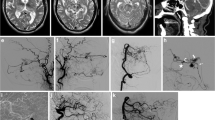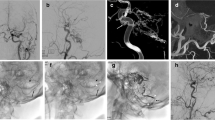Abstract
Background
Dural arteriovenous fistulas (DAVF) are commonly encountered lesions that can be treated both transvenously, transarterially or using a combined approach.
Objective
Transvenous coil embolization of DAVF is a recognized treatment option but can be challenging. In this context this article presents clinical experience using the Kaneka ED10 ExtraSoft coils in combination with the Marathon microcatheter to treat high grade DAVF. The physical properties of these coils and the microcatheter were also determined.
Material and Methods
All patients with high grade DAVF treated with the Marathon and the Kaneka ED COIL ∞10 ExtraSoft coils were retrospectively identified. The clinical presentation, location, grade of the lesion, clinical and radiological follow-up data were recorded. Bench side studies were performed to determine the physical properties of the Marathon catheter in comparison to the SL10 and Headway Duo as well the maximum width of the Kaneka pusher wire in comparison to Hypersoft, Target and Axium Prime coils.
Results
A total of 8 patients with 9 DAVF with 3 Cognard 3 and 6 Cognard 4 lesions were identified. All the DAVF’s were occluded either at the end of the procedure or on follow-up imaging. On bench side tests the Marathon microcatheter had the most flexible distal tip and distal shaft in comparison to the SL10 and Headway Duo. The proximal shaft of the Marathon was stiffer than the SL10. The Kaneka ED COIL ∞10 ExtraSoft had the smallest distal width and were the only coils tested that could be deployed through a Marathon microcatheter.
Conclusion
The combination of the Marathon microcatheter and Kaneka ED COIL ∞10 ExtraSoft is useful for the treatment of high grade DAVF.








Similar content being viewed by others
References
Kutluk K, Schumacher M, Mironov A. The role of sinus thrombosis in occipital dural arteriovenous malformations−development and spontaneous closure. Neurochirurgia (Stuttg). 1991;34:144–7.
Lawton MT, Jacobowitz R, Spetzler RF. Redefined role of angiogenesis in the pathogenesis of dural arteriovenous malformations. J Neurosurg. 1997;87:267–74.
Zhu Y, Lawton MT, Du R, Shwe Y, Chen Y, Shen F, Young WL, Yang GY. Expression of hypoxia-inducible factor-1 and vascular endothelial growth factor in response to venous hypertension. Neurosurgery. 2006;59:687–96. discussion 687–696.
Klisch J, Kubalek R, Scheufler KM, Zirrgiebel U, Drevs J, Schumacher M. Plasma vascular endothelial growth factor and serum soluble angiopoietin receptor sTIE-2 in patients with dural arteriovenous fistulas: a pilot study. Neuroradiology. 2005;47:10–7.
Li Q, Zhang Q, Huang QH, Fang YB, Zhang ZL, Xu Y, Liu JM. A pivotal role of the vascular endothelial growth factor signaling pathway in the formation of venous hypertension-induced dural arteriovenous fistulas. Mol Med Rep. 2014;9:1551–8.
Bhogal P, Yeo LL, Henkes H, Krings T, Söderman M. The role of angiogenesis in dural arteriovenous fistulae: the story so far. Interv Neuroradiol. 2018;24:450-4.
Cognard C, Gobin YP, Pierot L, Bailly AL, Houdart E, Casasco A, Chiras J, Merland JJ. Cerebral dural arteriovenous fistulas: clinical and angiographic correlation with a revised classification of venous drainage. Radiology. 1995;194:671–80.
Borden JA, Wu JK, Shucart WA. A proposed classification for spinal and cranial dural arteriovenous fistulous malformations and implications for treatment. J Neurosurg. 1995;82:166-79. Erratum in: J Neurosurg. 1995;82:705-6.
Davies MA, TerBrugge K, Willinsky R, Coyne T, Saleh J, Wallace MC. The validity of classification for the clinical presentation of intracranial dural arteriovenous fistulas. J Neurosurg. 1996;85:830–7.
VanLandingham M, Fox B, Hoit D, Elijovich L, Arthur AS. Endovascular treatment of intracranial dural arteriovenous fistulas. Neurosurgery. 2014;74 Suppl 1:S42-9.
Liebig T, Henkes H, Brew S, Miloslavski E, Kirsch M, Kühne D. Reconstructive treatment of dural arteriovenous fistulas of the transverse and sigmoid sinus: transvenous angioplasty and stent deployment. Neuroradiology. 2005;47:543–51.
Kirsch M, Liebig T, Kühne D, Henkes H. Endovascular management of dural arteriovenous fistulas of the transverse and sigmoid sinus in 150 patients. Neuroradiology. 2009;51:477–83.
Lekkhong E, Pongpech S, ter Brugge K, Jiarakongmun P, Willinsky R, Geibprasert S, Krings T. Transvenous embolization of intracranial dural arteriovenous shunts through occluded venous segments: experience in 51 Patients. AJNR Am J Neuroradiol. 2011;32:1738–44.
Albuquerque FC, Ducruet AF, Crowley RW, Bristol RE, Ahmed A, McDougall CG. Transvenous to arterial Onyx embolization. J Neurointerv Surg. 2014;6:281–5.
Lamin S, Chew HS, Chavda S, Thomas A, Piano M, Quilici L, Pero G, Holtmannspolter M, Cronqvist ME, Casasco A, Guimaraens L, Paul L, Gil Garcia A, Aleu A, Chapot R. Embolization of intracranial dural arteriovenous fistulas using PHIL liquid embolic agent in 26 patients: a multicenter study. AJNR Am J Neuroradiol. 2017;38:127–31.
Leyon JJ, Chavda S, Thomas A, Lamin S. Preliminary experience with the liquid embolic material agent PHIL (Precipitating Hydrophobic Injectable Liquid) in treating cranial and spinal dural arteriovenous fistulas: technical note. J Neurointerv Surg. 2016;8:596–602.
Chau Y, Sachet M, Sédat J. Super-selective coil embolization of a basilar perforator artery aneurysm previously treated by the stent-in-stent technique, using an extremely soft bare coil delivered through a one-marker microcatheter. Interv Neuroradiol. 2017;23:492–6.
Beckett JS, Duckwiler GR, Tateshima S, Szeder V, Jahan R, Gonzalez N, Vinuela F. Coil embolization through the marathon microcatheter: advantages and pitfalls. Interv Neuroradiol. 2017;23:28–33.
Horie N, Hayashi K, Morikawa M, Izumo T, Nagata I. A novel method for super-selective coil embolization using an extremely soft bare coil through a liquid embolic delivery microcatheter. Neurol Med Chir (Tokyo). 2015;55:605–9.
Harada K, Morioka J. Initial experience with an extremely soft bare platinum coil, ED coil-10 Extra Soft, for endovascular treatment of cerebral aneurysms. J Neurointerv Surg. 2013;5:577–81.
Miyachi S, Izumi T, Matsubara N, Naito T, Haraguchi KI, Wakabayashi T. The mechanism of catheter kickback in the final stage of coil embolization for aneurysms: the straightening phenomenon. Interv Neuroradiol. 2010;16:353–60.
Chapot R, Stracke P, Velasco A, Nordmeyer H, Heddier M, Stauder M, Schooss P, Mosimann PJ. The pressure cooker technique for the treatment of brain AVMs. J Neuroradiol. 2014;41:87–91.
Zhang G, Zhu S, Wu P, Xu S, Shi H. The transvenous pressure cooker technique: A treatment for brain arteriovenous malformations. Interv Neuroradiol. 2017;23:194–9.
Funding
This research received no specific grant from any funding agency in the public, commercial or not-for-profit sectors.
Author information
Authors and Affiliations
Corresponding author
Ethics declarations
Conflict of interest
P. Bhogal and M. Aguilar Pérez serve as proctors and consultants for phenox. H. Henkes is a co-founder and shareholder of phenox. M. AlMatter, V. Hellstern, H. Bäzner and O. Ganslandt declare that they have no competing interests.
Ethical standards
For this type of retrospective study formal approval is not required.
Additional information
Author Contribution
P. Bhogal, M. AlMatter, V. Hellstern data collection, manuscript preparation; H. Bäzner, O. Ganslandt review, editing, manuscript preparation; H. Henkes study design and concept, review; M. Aguilar Pérez guarantor
Rights and permissions
About this article
Cite this article
Bhogal, P., AlMatter, M., Hellstern, V. et al. High-Grade Dural Arteriovenous Fistulas. Clin Neuroradiol 29, 653–660 (2019). https://doi.org/10.1007/s00062-018-0724-y
Received:
Accepted:
Published:
Issue Date:
DOI: https://doi.org/10.1007/s00062-018-0724-y




